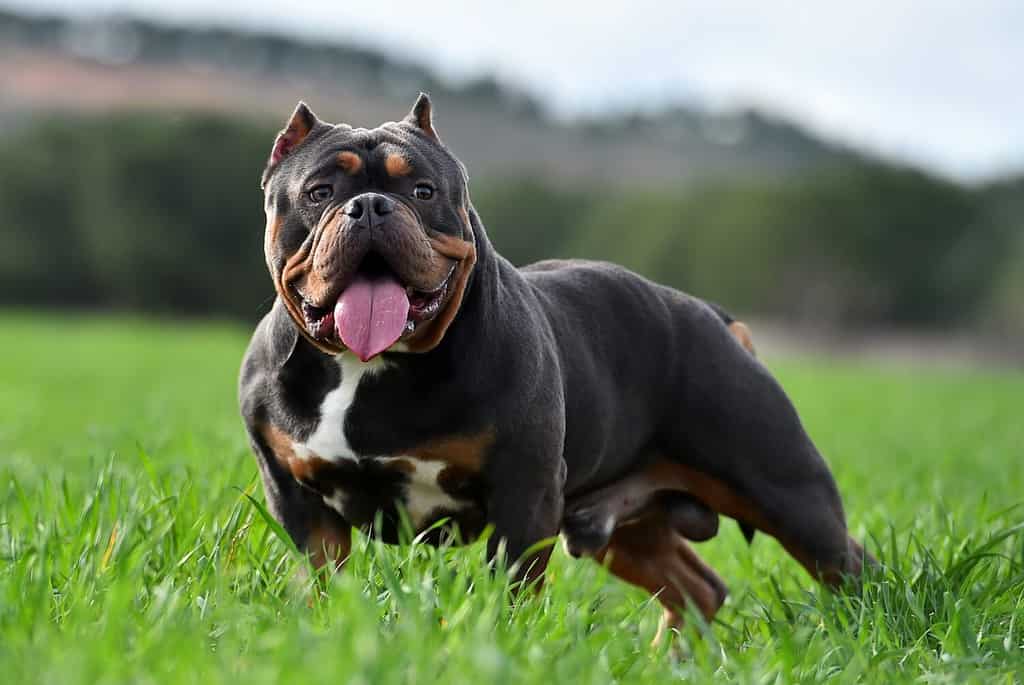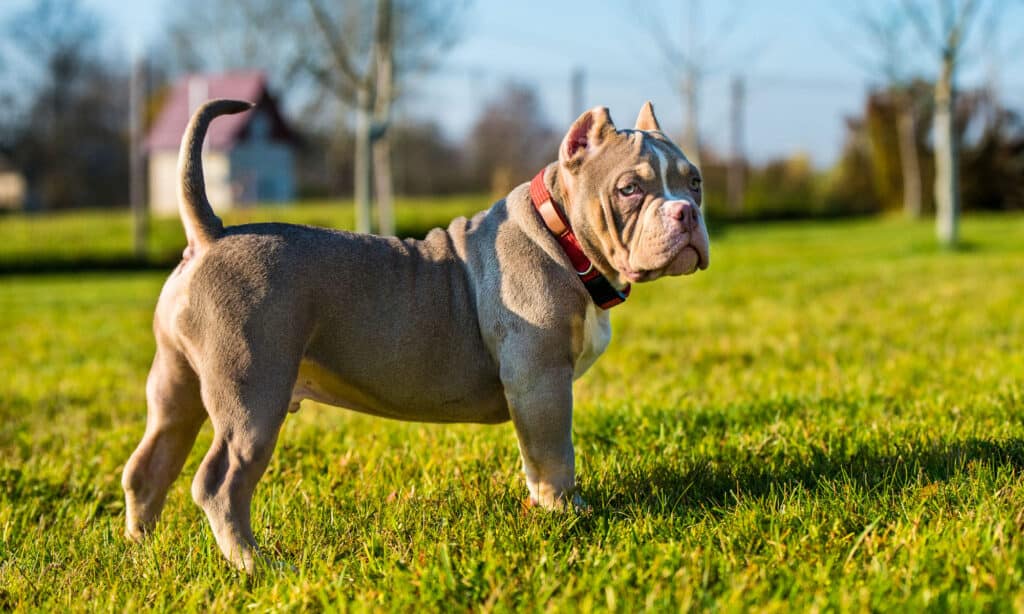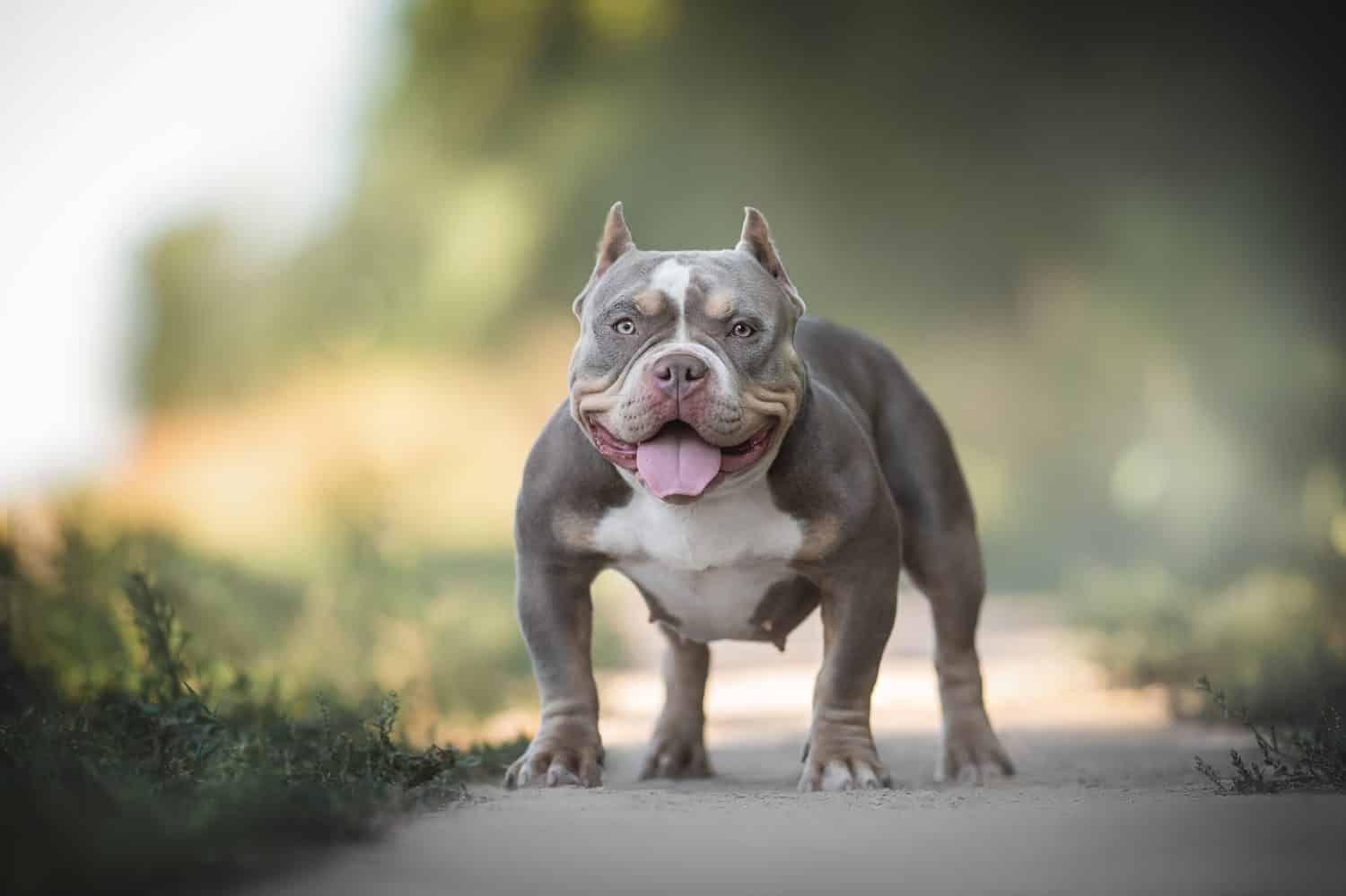Are you thinking about welcoming an American Bully puppy into your home? Our guide provides everything you need to know about nurturing a happy and healthy companion, including their full-grown size, when they’ll reach maturity, and how to raise a loyal, loving pet.
American Bully Summary

American Bullies are often confused with American bulldogs. However, Bullies are typically smaller and have a more stiff and glossy coat type.
©Christine Reisner/iStock via Getty Images
Breeders developed the American Bully in the 1980s. They perfected the breeding in the 1990s, resulting in a dog with a muscular build and confident demeanor, known for its loyalty and protectiveness.
The breed is rooted in the American pit bull terrier and refined with traits from bulldog varieties. It was officially recognized by the United Kennel Club (UKC) in 2013 and in 2004 by the American Bully Kennel Club (ABKC). Yet, it remains unrecognized by the American Kennel Club (AKC), at least at the moment of writing.
Often mistaken for the American bulldog or pit bull, the American Bully possesses a short, easy-care coat in a palette of colors. This breed comes in four sizes, categorized by height rather than weight: Standard, Classic, Pocket, and XL. Some breeders also produce other, non-standard sizes, such as Micro and XXL. However, kennel clubs do not recognize these sizes as legitimate varieties.
Overall, the American Bully is a cherished family pet, valued for its friendly and gentle nature. These pups have moderate to high energy levels and are typically considered a medium-sized breed. We’ll explore the growth milestones you can expect during their lifetime below.
American Bully Growth and Weight Chart by Age
The below weight chart is based on the standard expectations for this breed. However, the exact weight at any age may vary, especially due to the differences between the aforementioned varieties of the American Bully. On top of that, genetics, exercise, and diet can cause additional deviations from this table. We always advise consulting your vet or referring to a variety-specific weight chart for more precise assessments.
| Age | Male Weight | Female Weight |
|---|---|---|
| Birth | 0.62-1 lbs | 0.62-1 lbs |
| 1 Month | 7-15 lbs | 5-12 lbs |
| 2 Months | 15-25 lbs | 10-20 lbs |
| 3 Months | 20-35 lbs | 15-30 lbs |
| 4 Months | 35-45 lbs | 25-40 lbs |
| 5 Months | 40-55 lbs | 30-50 lbs |
| 6 Months | 50-70 lbs | 40-60 lbs |
| 7 Months | 60-80 lbs | 50-70 lbs |
| 8 Months | 65-85 lbs | 55-75 lbs |
| 9 Months | 70-90 lbs | 60-80 lbs |
| 10 Months | 75-95 lbs | 65-85 lbs |
| 11 Months | 80-100 lbs | 70-90 lbs |
| 12 Months | 85-120 lbs | 75-110 lbs |
| 2 Years | 90-120+ lbs | 80-110+ lbs |
When Will My American Bully Stop Growing?

Adult American Bullies have a stocky and sturdy build, and typically weigh between 80 and 120 pounds, depending on their sex.
©alberto clemares exposito/Shutterstock.com
American Bullies typically reach their adult height by the time they’re one year old. However, they continue to develop in muscle and bone density until about two years old. They grow rapidly and reach half of their full weight by the time they are six months old, with growth slowing down afterward.
Pocket varieties might reach full height sooner than larger ones. However, in all cases, health, nutrition, exercise, and genetics will significantly influence the growth of your pup. A balanced diet in particular is crucial for optimal development.
American Bullies generally need 1.5 to 2.5 cups of high-quality dry food each day, divided into two meals. They should also always have access to fresh water. The exact amount of food they’ll need will, however, depend on their size, age, and energy levels. Different dog food brands may also have specific feeding guidelines, so make sure to check those in advance.
You will also want to take your American Bully for regular vet checkups to monitor your puppy’s growth more closely and accurately. Puppies also need several visits in their first year for vaccinations and health monitoring. Adults, on the other hand, should go for annual wellness exams to ensure they are thriving.
How Big Will My American Bully Be When It’s Fully Grown?
We’ll provide estimates for the sizes of different American Bully varieties below. However, please note that these sizes are based on averages. The size of an individual dog can vary, especially based on their diet, lineage, and overall health. The length of the American Bully, measured from the nose to the base of the tail, generally correlates with their height, but it can also differ depending on the dog.
Also, as we’ve already mentioned, a well-balanced diet and proper care are vital for helping your American Bully reach its full-size potential. With that said, here are the sizes of different varieties of fully-grown American Bullies.
- Pocket American Bully: This is the smallest American Bully variety. Adult males usually weigh between 30 and 60 pounds, and females between 30 and 50 pounds. Males stand about 14-17 inches tall, and females are slightly shorter.
- Standard American Bully: Adult male Standard Bullies typically weigh 65-85 pounds, and females 60-80 pounds. The height ranges from 17 to 20 inches for males and between 16 and 19 inches for females.
- Classic American Bully: Classic Bullies match Standard Bullies in weight but have a lighter frame. Males and females weigh 65-85 pounds and 60-80 pounds, respectively. Their height is similar to the Standard variety.
- XL American Bully: The largest type, XL males weigh 80-150 pounds, and females weigh 70-120 pounds. Males are 20-23 inches tall, and females range from 19 to 22 inches in height.
The Biggest American Bully Ever Recorded
King Leonidus Jr. holds the title of the World’s Largest American Bully, boasting an impressive 150 pounds of pure muscle. Born from a lineage of prestigious Rednose Pitbulls and the direct offspring of King Leonidus Sr., this extraordinary dog exemplifies the pinnacle of physical strength and power for the breed.
To put this in perspective, American Bullies typically range in weight from 70 to 120 pounds for males, with females being slightly smaller on average. The size of King Leonidus Jr. far exceeds these averages, marking him as a remarkable specimen within the breed.
When Should My American Bully Be Spayed or Neutered?

Some vets advise spaying or neutering larger breeds, like the American Bully, a bit later in life.
©alberto clemares exposito/Shutterstock.com
You should consider spaying or neutering your puppy between four and nine months of age. Doing so can prevent specific health issues and often even lead to a more balanced temperament.
- Spaying females before their first heat can significantly reduce their risk of mammary cancer.
- For males, neutering can decrease the likelihood of prostate problems and testicular cancer.
- Additionally, having your dog spayed or neutered can help reduce pet overpopulation by preventing accidental litters in homes with unaltered pets.
However, the best timing can vary based on each dog’s health and needs. It’s best to consult a veterinarian to decide the most suitable age for your American Bully, considering factors like size, health, and lifestyle. Some vets believe that larger breeds, like the American Bully, should be spayed or neutered slightly later in life or, more precisely, around 10-12 months of age.
That way, you let them reach their full height — or at least get slightly closer to it — before they are spayed or neutered. Some say this can help prevent orthopedic issues.
However, if you do decide to go with this option, be prepared to deal with your dog during the first heat cycle. Well, actually, only females go into heat, usually around or after six months of age. Male dogs, however, reach sexual maturity when they’re about six months old.
When Should My American Bully Be House Broken?
Begin housebreaking your American bully between nine and 12 weeks of age, aiming for them to be fully trained by the time they’re four to six months old. Practice patience and maintain consistency, taking them outside after meals and naps and rewarding successful bathroom breaks. If accidents occur, clean promptly with an enzymatic cleaner without resorting to scolding. Stick to a regular schedule for bathroom breaks and use rewards to reinforce positive behavior.
When Should My American Bully Stop Eating Puppy Food?

Switching from puppy to adult food is just as important as giving your pup adequate portions of balanced meals.
©cynoclub/Shutterstock.com
These puppies should transition to adult food around 12-15 months of age, which is when they typically reach full size. However, individual growth rates vary, so it’s important to consult your veterinarian for the best timing. Signs that your American Bully is ready for adult food include reaching full adult size, no longer growing rapidly, maintaining a healthy weight and body condition, and digesting adult food without issues.
Transition them gradually over seven to 10 days. Start with a mix of 25% adult food and 75% puppy food, and then gradually increase the adult food proportion. If you observe changes in appetite, digestion, or stool, consult your veterinarian.
For suggestions on the best dog food according to their age, check out our article Best Dog Food for American Bullies.
When Will My American Bully Start Losing Teeth?
American Bullies usually start losing their puppy teeth and growing adult teeth at four to six months old. To help manage their discomfort and increased chewing, give them appropriate chew toys during this time. These toys can soothe their gums. You can also offer frozen treats, like ice cubes or dog-friendly frozen items, to numb any pain.
Regularly check their mouth for dental issues and maintain good dental hygiene. If you notice any dental problems or if they seem excessively uncomfortable, it’s best to consult a veterinarian.
When Should I Start Training My American Bully?

The sooner you start, the better results you can expect!
©Oksamutnaya/Shutterstock.com
Start training your Bully immediately after you bring them home to establish good habits and prevent undesirable behaviors. Early training is vital for instilling discipline and asserting your role as the dog’s leader. Use positive reinforcement, rewarding and praising their good behavior to foster learning and set clear expectations.
Before training sessions, make sure to meet their physical needs. First and foremost, try to ensure that your Bully gets enough physical exercise, as this will help them focus. Pair this with mental stimulation to prevent boredom and boost their training experience. Also, try to start socializing them early with different people and dogs. That way, you’ll build a confident, well-adjusted adult.
You should equip your dog with a robust, well-fitting collar and leash appropriate for their muscular build. Avoid using negative reinforcement tools like choke, prong, or shock collars.
What Cues Should I Teach My American Bully First?
To train your American bully, start with these essential cues:
- Sit: Teach them to sit to stay calm and focused.
- Stay: Once they master sitting, train them to stay put, gradually increasing duration and distractions.
- Down: Progress from sit to down, rewarding them for lying down.
- Come or Here: Use treats to teach them to come when called, gradually increasing distance and reducing treat dependency.
Remember that consistent, engaging, and positive training sessions are crucial for successfully training your dog, making the process enjoyable and effective for both of you.
When Will My American Bully Calm Down?

Daily exercise is a must for this medium- to high-energy breed.
©Zanna Pesnina/Shutterstock.com
Your American Bully might start to calm down around two years old, but this can vary up to four or five years. Regular exercise and mental stimulation significantly affect their behavior. It’s important to provide daily physical activities and start early training and socialization using positive reinforcement.
Bullies may remain hyper into adulthood due to:
- Inadequate training and socialization.
- Boredom and lack of attention.
- Insufficient exercise.
- Separation anxiety.
- Hyperkinesis (a condition similar to ADHD in humans).
To manage these behaviors, practice consistent training and patience. If behavior issues persist, consider consulting a professional trainer. Early intervention is crucial to prevent these tendencies from becoming ingrained as they mature.
Common Health Issues Your American Bully Might Experience
American Bullies are generally healthy. However, like all dog breeds, they can develop certain health issues over time. Age, of course, greatly influences your pup’s health and overall well-being.
The most common ailments for this breed include:
- Hip Dysplasia: A condition where the hip joint doesn’t develop properly, leading to pain and arthritis, commonly seen in larger dogs.
- Elbow Dysplasia: Similar to hip dysplasia, only it affects the elbow joint.
- Patellar Luxation: The kneecap dislocates from its normal position, possibly due to genetics, injury, or overuse.
- Brachycephalic Syndrome: This syndrome affects dogs with short snouts, American Bullies included. It can lead to breathing difficulties, overheating, and other health issues.
- Eye Problems: American Bullies may also develop eye issues like cataracts, glaucoma, and cherry eye. These conditions are pretty common in most dog breeds.
- Skin Problems: They are prone to allergies, eczema, and seborrhea. In most cases, skin problems can only be treated, not cured.
- Hypothyroidism: The underactive thyroid gland causes weight gain, lethargy, and hair loss.
- Heart Disease: Risk of congenital heart defects and cardiomyopathy.
You should take your Bully for regular veterinarian checkups to detect and treat health issues early, especially as they age.
To ensure a long, healthy life for your American Bully, follow these steps:
- Feed them a high-quality, nutritious diet.
- Make sure they exercise enough but avoid pushing them too hard.
- Maintain a healthy weight.
- Keep their coat, skin, and teeth clean.
Pictures of American Bully as Puppy

Most people consider American Bullies to be puppies until they are six months old.
©Sushitsky Sergey/Shutterstock.com
Pictures of American Bully at 6 Months

By the time they are six months old, American Bullies reach half of their full, adult weight. However, they have not yet fully lost their puppy look.
©HIRAN NANCHIANG/Shutterstock.com
Pictures of Fully Grown American Bully

Adult American Bullies have a strong and powerful appearance, no matter which variety they belong to.
©Liudmila Bohush/Shutterstock.com
Other Dog Breeds Similar to American Bully
If you’re not convinced that the American Bully is the right dog for you, check out these similar breeds:
Ready to discover the top 10 cutest dog breeds in the entire world?
How about the fastest dogs, the largest dogs and those that are -- quite frankly -- just the kindest dogs on the planet? Each day, AZ Animals sends out lists just like this to our thousands of email subscribers. And the best part? It's FREE. Join today by entering your email below.
Thank you for reading! Have some feedback for us? Contact the AZ Animals editorial team.







